Ark of the Covenant Discovery, Part 4
The Hole that Held the Cross?
As should be expected, there was a great deal of dirt and debris
everywhere. As he examined this hole and cleared away the dirt around it,
he discovered that it had a large crack extending out from it. As they
removed more dirt and debris, he discovered a platform-like section of
bedrock which extended out about 8 feet from the face of the cliff, and
the square-like hole was here.
There were no more holes in the platform-like platform, so he began
digging into the packed earth in front of and even with the platform.
It was about four feet down before he came to a lower level of bedrock, and
here he uncovered three more squarish holes chiseled in the rock in front
of the platform. His measurements showed that the elevated platform
with the single squarish hole and crack were located fourteen feet directly below
the three cut-out niches in the face of the cliff, now above ground level.
His earlier conclusion that the cut-out niches were for the signs stating
the crucifixion victim's crime in the three languages of Jerusalem, was now
supported by the fact that he had found more square holes, all about
twelve to thirteen inches square, cut into the bedrock -- holes he firmly
believed once held crosses. Ron believed the one cross hole elevated above the rest
on the platform was used in the execution of Christ!
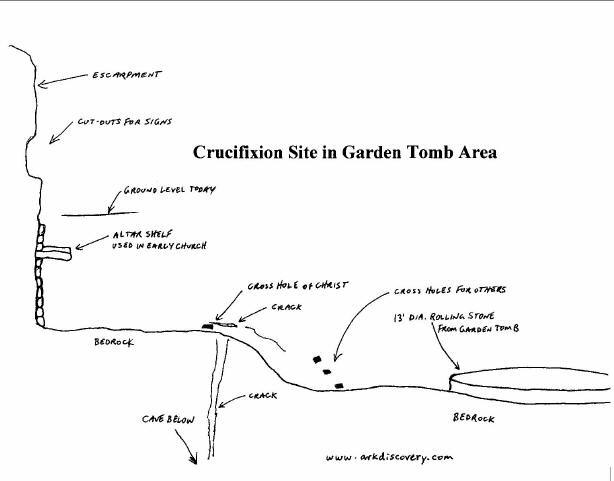
The building structure that remained intact showed that a building
covered the entire site. He concluded, based on the evidence they'd found,
that a Christian church had been built over the place of the crucifixion
of Christ - the stone wall extended along the cliff-face directly behind
the cross-hole that was on the bedrock platform. It
appeared that this was the place where the featured criminal-victim was
crucified, being elevated several feet above those crucified around him.
The altar stone was set in the stone wall, extending out horizontally
almost directly above the elevated cross-hole with the crack.
The Crack in the Cross-Hole
The crack extending out from the cross-hole on the elevated platform
appeared to Ron to have been caused by an earthquake - it displayed no
evidence of man-made fabrication.

As he removed debris from the cross-hole, he finally reached the bottom
and measured it - it extended 23.5 inches into the solid bedrock, while
the crack appeared to extend much deeper. But at this time, he didn't
attempt to clear it out nor did he measure it. It would be over a year
later before he would learn that the crack extended about twenty feet into
the bedrock.
Dating the Remains of the Building
He found coins during the course of the excavation which helped to
narrow the date of the building. He found a Roman coin with Emperor
Tiberius who was Emperor from 14 to 37 AD, which was the earliest dated
coin they found. The latest coins were from about 135 AD, but no later.
This is consistent with the known history of Jerusalem and placed the date
of the building between the time of the crucifixion and 135 AD. But
further information indicates that it was most likely built after 70 AD.
Prior to 70 AD, (when the city and the temple were completely destroyed by
the Roman general, Titus), Jerusalem was still under Roman rule and the
crucifixion grounds would have remained in use. Josephus tells how Titus,
during his siege of Jerusalem, had as many as 500 people per day crucified
(Wars of the Jews, Book V, Chapter XI, para. 1).
After 70 AD- No More Mass Crucifixions
But after the destruction in 70 AD, with most of the Jewish inhabitants
having been killed or sold as slaves, the city was reduced to a Roman
camp. Vespasian offered the landed property of Jerusalem for sale to
foreigners, although we have no records of who purchased any land there.
A garrison of eight hundred Romans in the camp was stationed there to
insure that the city was not rebuilt. The hatred of the Romans was for the
Jews. Therefore, during the time after 70 AD, when Jerusalem was only a
Roman camp with the occasional foreigner (non-Jew) living in the area, the
use of crucifixion would be virtually eliminated.
The Christians were apparently tolerated by the Romans, as is supported
by the fact that in 130 AD, when the Emperor Hadrian came to Jerusalem to
rebuild it as a Roman city named Aelia Capitolina, he showed favor to the
Christians while forbidding any Jew to ever set foot in the city again.
This and other things contributed to a revolt among the Jews in Judea in
132 AD, which finally resulted in the death of at least half a million
Jewish men, and from this time on Judea was no longer called by that
name, but referred to by the old name of Palestine.
The new Roman city of Aelia Capitolina remained a city, but did not
prosper. The fact that the coins Ron found in the ancient building cease
at about 135 AD, indicates that whoever built and used this ancient
structure apparently abandoned it at that time and left the region. The
fact that the foundations are still intact indicates that it didn't suffer
destruction at the hands of an invader, but most likely fell into disuse
and decay. Eventually over time, it was covered in dirt and debris.
Whatever was the case, the evidence shows that the structures were not
disturbed since the Roman time.
"A VERY GREAT Stone"
As they continued to clear the area outward from the cliff-face, the
layout of the building was found to be very simple. One wall ran parallel
to the cliff-face, along the elevated platform section of
bedrock. Two exterior walls extended out at 90 degree angles from each end
of this first wall. They began to dig, searching for the last wall when
they came to another hand-hewn rock. It was a little less than two feet
thick, and the portion that was extending out of the dirt and debris
looked as if it were curved.
Clearing more soil from around it, Ron saw that it was of immense size and
they decided not to continue digging. He theorized that perhaps this was
the seal-stone from the tomb of Joseph of Arimathaea in which Christ was
buried. If he was correct in his earlier conjecture that this was an early
Christian church building, perhaps they had incorporated this seal-stone
into the actual building. It certainly appeared to be larger than any seal
stone he had ever seen or read about. The largest that had ever been
found, to his knowledge, was 5.5 feet in diameter. This stone would far
exceed that.
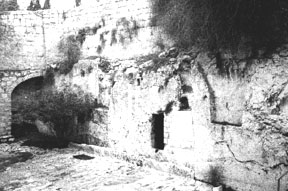
However, it would be several years later before he would learn its true
dimension -- a little over thirteen feet in diameter - when he used
sub-surface interface radar from above the ground to measure it.
"And laid it in his own new tomb, which he had hewn out in the rock:
and he rolled A GREAT STONE to the door of the sepulcher, and departed." MAT 27:60
"In the Garden a New Sepulcher"
In the same escarpment is the Garden Tomb which was discovered in 1867,
when the landowner was digging a cistern on his property. As with the
sites Ron was excavating, this tomb was beneath the ground level, buried
in the debris of many, many years. When the owner discovered the tomb, he
abandoned his plans for a cistern. When General Gordon of Britain visited
the area and became convinced that the "skull face" in the relatively near
section of the escarpment was the true location of Golgotha, this tomb
became the prime prospect for being the tomb of Christ.
It met with strenuous opposition from the traditionalists who were
adamant that the Holy Sepulcher inside the city was the true site -- but
it soon gained some adherents.
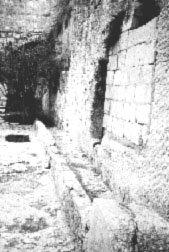
When completely excavated, it did indeed exhibit characteristics which
proved it was dated to the 1st century AD, the time of Christ. But the
subject that now concerns us is the missing seal-stone from this tomb.
Directly in front of the tomb is a groove for a rolling stone. The width
of this groove is about two feet, the correct size for the stone Ron found
buried in the earth.

Another tomb from the 1st century (time of Christ) is that of Queen
Helena of Adiabene. It is also located in the same general vicinity,
further north, and the groove is exactly the same size as is featured in
the Garden Tomb. Not only are the grooves for the seal stones identical in
size, hers also contains an inclined section at one end at which the stone
was rolled into the groove - exactly as does the Garden Tomb.
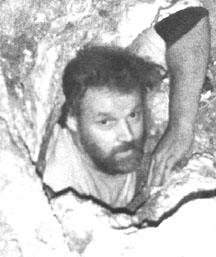
Almost 2 Years of Excavating
By this time, Ron and the boys had been working here for almost two
years. They had begun in January of 1979, and it was now late 1980. Of
course, they weren't working constantly - Ron was
an anesthetist with obligations to the hospitals he worked with. Due to
the nature of his work, he was able to arrange to come over numerous times
each year, but they could only stay for a few weeks at a time. And Ron was
getting anxious. They had made some wonderful discoveries, and provided
details to the authorities of their finds along with any artifacts they
found. Some they were allowed to keep because they were deemed of no
significant worth.
But they had explored the entire underground cliff-face, looking for an
entrance into a cave or tunnel. If the Ark was in that location, it
certainly would be hidden in a cave he reasoned. Finally, as they
continued to search, Ron made the comment to the boys that he was
impressed that they should just break through the rock of the
cliff-face. Ronny said he thought that was a good idea, but Ron resisted.
That rock is extremely hard and he knew what difficult work it would be.
Finally, when Danny told his father that he, too, believed they ought to
do go ahead and break through the cliff face, Ron relented and agreed. It
was the only option left.
With hammers and chisels, they began their work. It wasn't long before
they broke through the rock into an open space. Enlarging the hole, they
saw a cave behind it which was about 15 feet in height and of about the
same width. Crawling through, they finally were inside the actual mountain
called Moriah.
Inside the Cave System
For almost two years, they had been tunneling underground, finding
artifacts and uncovering exciting structures almost daily. But now, they
were in a barren cavern that they would soon learn was only a very small
part of a very extensive honeycomb of natural caves and tunnels within the
mountain.
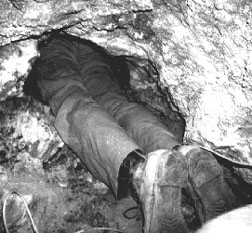
For almost a year, they explored this area, finding no evidence of any
human presence. These natural tunnels were not all connected to each
other, and they spent many hours chiseling through cave walls, searching
for adjacent tunnels which they eventually found. But they found nothing
else to this point.
As 1981 came to an end, Ron and the boys took their winter holidays to
come to Jerusalem and work. Even though it is cold there in the winter,
the cave system was always a very comfortable and constant temperature,
both in summer as well as winter. But the work was beginning to take a
toll on all three of them. They all began to develop a fever and slight
chills. The dust they had inhaled over the years in those confined tunnels
perhaps contributed to their pneumonia-like symptoms. Finally, on
Christmas eve, Ron had to send Ronny back to the U.S. because he was so ill. Danny had to follow on New Year's eve. Ron too was sick but this was a
very special trip and he had work to do.
Next Page: More on the Ark of
the Covenant
INDEX
This page courtesy anchorstone.com
|

![]()